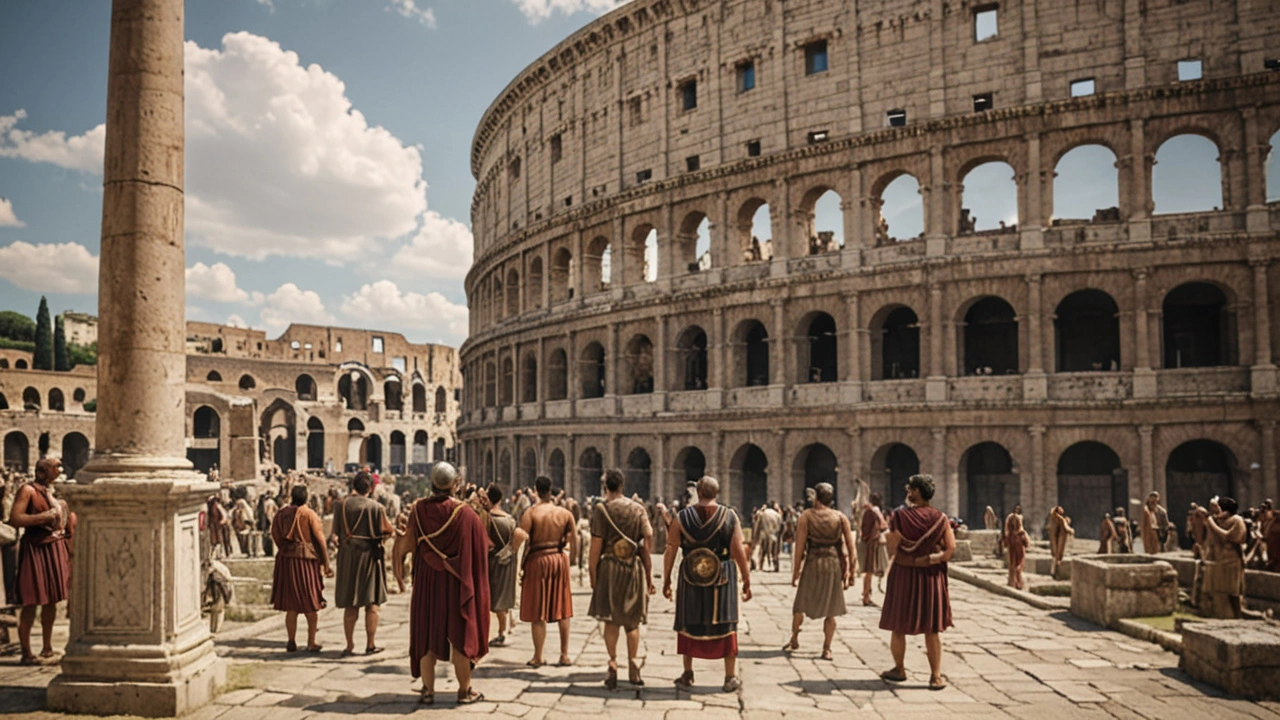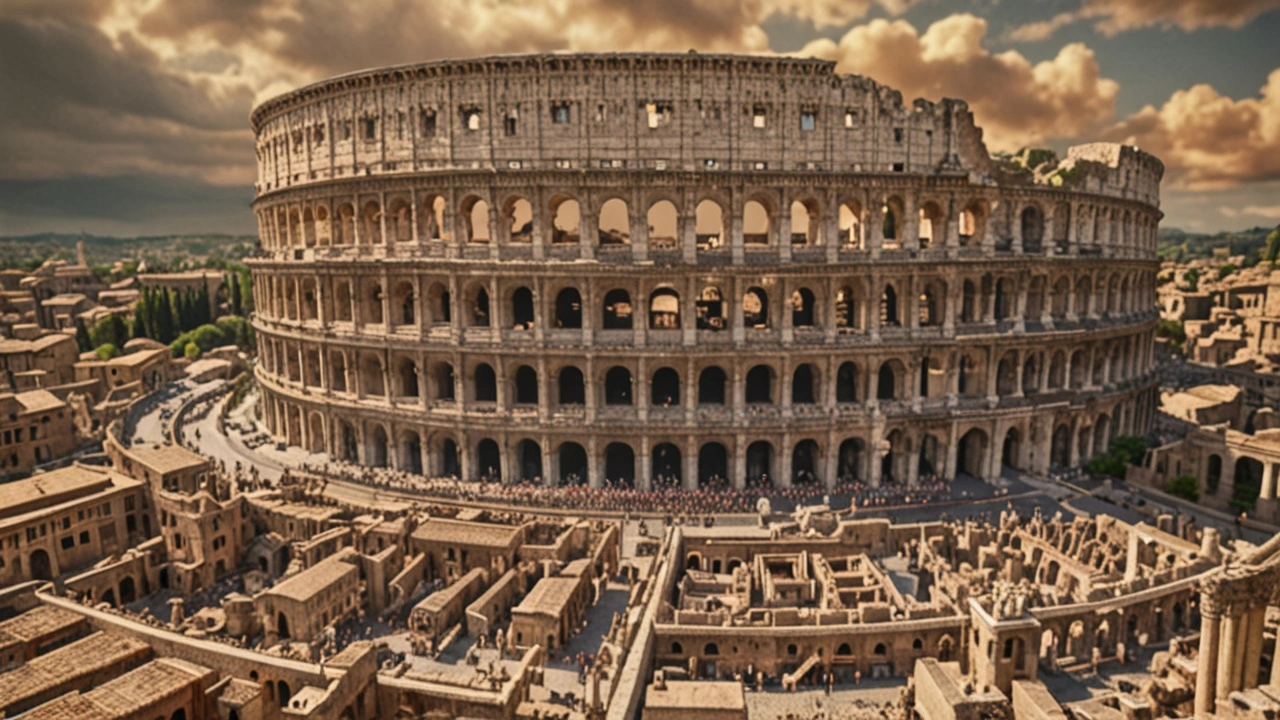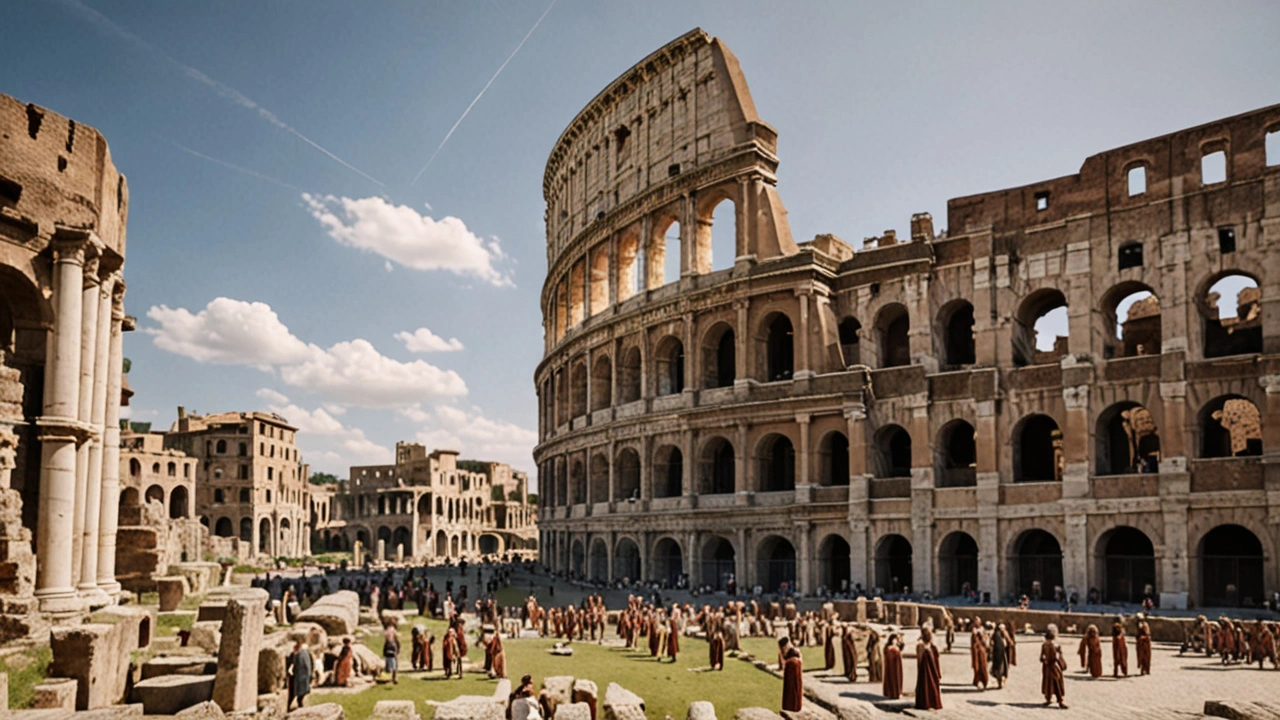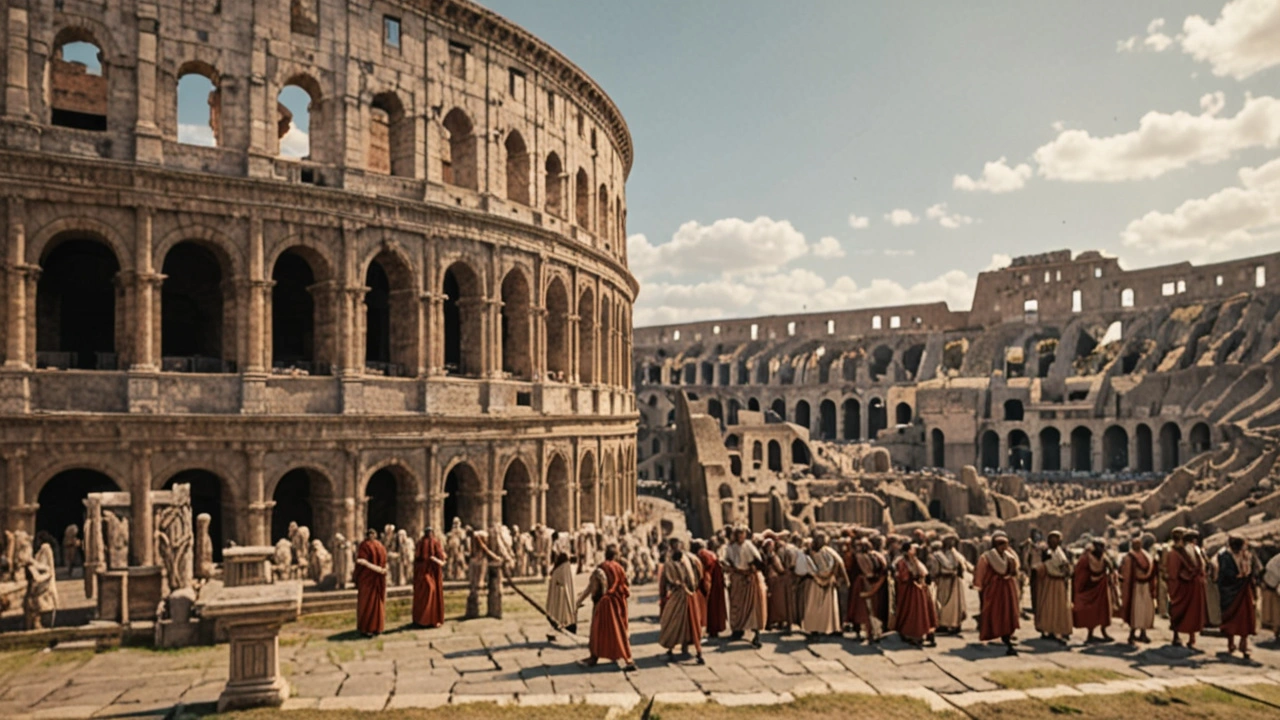Unlocking the Secrets of Ancient Roman Architecture
 Jul, 9 2024
Jul, 9 2024
Ancient Roman architecture stands as a testament to the ingenuity and resourcefulness of a civilization that thrived thousands of years ago. From the grand coliseums to the intricate aqueducts, Roman structures continue to inspire awe and admiration.
Their mastery over various elements of building, combined with their innovative spirit, led to the creation of monuments that have endured the test of time. This article explores the secrets behind their architectural prowess.
Materials and Techniques
When it comes to ancient Roman architecture, one cannot ignore their ingenious use of materials and construction techniques. Romans were pioneers in the use of concrete, which allowed them to create structures that were not only massive but also highly durable. This innovation made it possible to build grandiose buildings like the Pantheon and the Colosseum, which still stand today.
Roman concrete, known as opus caementicium, was a mix of lime mortar, water, sand, and a volcanic ash called pozzolana. This mixture was highly versatile and less prone to cracking under stress compared to modern concrete. According to Pliny the Elder, a renowned Roman author, 'There is nothing in the world which binds better together than this stuff.'
The Romans also excelled in their use of bricks and marble. Bricks were often used for the core of walls and hidden beneath a veneer of marble. This not only gave the structures a majestic look but also made them more resilient. The Romans extracted marble from quarries in Carrara, Tuscany, and even imported exotic stones from Egypt and Greece to adorn their buildings.
Roman engineers were masters of the arch and the dome, structures that allowed them to build larger and more stable edifices. The use of the arch reduced the amount of material needed without compromising the strength of the structure. The dome, on the other hand, allowed for the creation of expansive interior spaces. The Pantheon’s dome, with a diameter of 43 meters, remains one of the largest unreinforced concrete domes in the world.
In addition to their materials, the Romans also implemented advanced construction techniques. The use of the centering technique in arches and vaults, where wooden frameworks supported the stonework until the mortar set, exemplifies their ingenuity. The Roman aqueducts, a marvel of engineering, employed precise gradients to transport water over long distances. The Aqua Claudia and Aqua Anio Novus are prime examples of this.
The Romans’ ability to marry functionality with aesthetic appeal is perhaps best seen in their roads. Made from layers of stones and gravel, Roman roads were designed to last, with some still in use today. These roads facilitated efficient movement across the vast Roman Empire and were crucial for trade and military expeditions.
Another fascinating technique was the use of hypocaust systems in Roman baths and houses. This early form of central heating involved the circulation of hot air beneath the floors and through the walls, showcasing the Romans’ concern for comfort and ingenuity in solving practical problems. Interesting fact: the durability of Roman concrete has baffled modern scientists, who have discovered that seawater reacting with the volcanic ash created crystals of aluminium tobermorite, which prevented cracks from spreading.
The ancient Romans also applied intricate decorative techniques such as mosaics and frescoes to beautify their spaces. Mosaic floors, composed of tiny colored stones or glass pieces, often depicted scenes from mythology or daily life. Frescoes, created by applying pigments to wet plaster, adorned the walls of villas, public baths, and temples, adding a touch of vibrant color and storytelling to the Roman aesthetic.
By employing a combination of groundbreaking materials and innovative techniques, the Romans set a benchmark in architecture that continues to be admired and studied worldwide. Their legacy is not just in the structures that have survived millennia, but in the principles and practices that have influenced architectural design to this day.

Famous Structures
Among the wealth of architectural wonders crafted by the Romans, several structures stand out for their grandeur, complexity, and influence on architectural styles that followed. One of the most iconic is the Colosseum, or the Flavian Amphitheatre, in Rome. Constructed from AD 70-80, this massive arena could hold up to 80,000 spectators and was used for gladiatorial contests, mock sea battles, and public spectacles. The Colosseum's design included a sophisticated system of corridors and ramps to manage crowds, revealing the Romans' skill in creating functional yet monumental public spaces.
Another remarkable structure is the Pantheon, a temple dedicated to all Roman gods, constructed during Emperor Hadrian's reign around AD 118-125. Its most striking feature is the large dome, which remained the world's largest unreinforced concrete dome until modern times. The Pantheon's oculus, a central opening at the dome's peak, provides natural light and underscores the building's harmonious proportions. The Pantheon remains one of the best-preserved ancient Roman buildings and continues to influence architectural design.
No discussion of Roman architecture would be complete without mentioning the aqueducts. The Aqueduct of Segovia, built at the end of the 1st century AD, is a masterpiece of engineering. It transported water from the Frío River, over 15 kilometers away, to the city of Segovia, Spain. The structure, made of granite blocks without the use of mortar, features a series of towering arches that have stood the test of time. Aqueducts like this one exemplify the Romans' ability to solve practical problems with profound ingenuity.
The ancient city of Pompeii also provides a fascinating glimpse into Roman architectural achievements. Buried by the eruption of Mount Vesuvius in 79 AD, Pompeii was preserved under volcanic ash. Excavations have uncovered homes, baths, shops, and public buildings that illustrate Roman urban planning and domestic architecture. Key sites include the House of the Faun, renowned for its elaborate mosaics, and the Forum, which served as the city's center of public life.
The great architect Vitruvius once said, "Architecture must meet three requirements: strength, utility, and beauty." Roman designs, with their impressive columns, arches, and use of concrete, exemplify these principles.Among the lasting legacies of Roman architecture is the Arch of Constantine, dedicated in AD 315 to commemorate Constantine I's victory at the Battle of Milvian Bridge. This triumphal arch in Rome showcases intricate relief sculptures and served as a model for many subsequent monuments throughout Europe. Each structure, be it a grand amphitheater or a humble home, reflects the Romans' architectural prowess and their ability to merge practical design with aesthetic appeal. Their understanding of balance and symmetry, combined with innovations like the use of concrete and the arch, ensures these structures are more than historical artifacts; they are lessons in enduring architectural excellence.

Engineering Marvels
When it comes to engineering marvels, ancient Rome deserves endless accolades. The Romans demonstrated an extraordinary ability to combine practical engineering with aesthetic splendor, producing structures that are both functional and visually captivating. One of the most iconic examples is the Roman aqueduct. These impressive water supply systems, some stretching over 50 kilometers, were crucial for urban life, ensuring that cities had access to fresh water.
Aqueducts weren't just practical, they were also beautifully designed. Take the Pont du Gard in France, for instance. This towering structure not only transported water but also showcased the Romans' remarkable sense of design. Built with precision, the aqueduct features three tiers of graceful arches, each playing a role in maintaining the balance and strength of the entire structure.
Another breathtaking feat of Roman engineering is the Colosseum. Completed in AD 80, this amphitheater remains one of the largest ever built. It could hold up to 50,000 spectators and featured a complex system of vaults and arches that supported the massive structure. Many of these elements are still in use in modern stadiums and arenas. It's truly amazing to consider how such an enormous building was constructed without the machinery we have today.
The Romans also excelled in road construction. Their extensive network of roads, known as the viae, stretched across the entire empire, facilitating trade and military movement. The techniques they used, including layered construction for drainage and durability, are considered engineering masterpieces. Roads like the famous Appian Way reveal the sophistication of Roman planning and their commitment to connectivity.
"The breadth of the Roman achievement in construction and engineering is a gift that continues to benefit our modern world." – Dr. John Taylor
Baths were another marvel of Roman engineering. The Baths of Caracalla and the Baths of Diocletian are prime examples. These were not merely places for bathing but also centers for socializing and leisure, featuring heated rooms, swimming pools, and even libraries. The hypocaust system, which involved heating from below the floor, was used to warm the air and water, demonstrating their advanced approach to heating systems.
The use of concrete revolutionized Roman architecture. Unlike earlier civilizations, which relied on stone and wood, the Romans developed a concrete mix that was durable and versatile. This innovation allowed them to create more complex and larger buildings like the Pantheon, which boasts a massive dome that remains the largest unreinforced concrete dome in the world. The coffered ceiling and oculus of the Pantheon continue to awe architects and tourists alike.
Overall, the engineering expertise of the Romans laid the groundwork for many modern structures. Their ability to blend functionality with style, their innovative use of materials, and their complex construction techniques are lessons that continue to influence contemporary architecture. From aqueducts to amphitheaters, Roman engineering marvels are emblematic of a civilization that valued ingenuity and beauty.

Cultural Influences
When examining the architectural wonders of ancient Rome, it's pivotal to understand the profound cultural influences that shaped their iconic designs. Roman architects didn't operate in a vacuum; instead, they borrowed, adapted, and innovated based on the myriad cultures they encountered and integrated into their vast empire.
One of the most noteworthy influences on Roman architecture came from the Greeks. The admiration Romans had for Greek art and buildings is evident in their structures and planning. For instance, the use of columns, especially the Doric, Ionic, and Corinthian orders, was directly borrowed from Greek designs. The Pantheon, with its imposing Corinthian columns, serves as a perfect example of this Athenian inspiration melded with Roman innovation.
Beyond Greece, the Romans were significantly influenced by the Etruscans, particularly in terms of urban planning and the use of arches. While arches might seem rudimentary to us today, their wide-scale use in bridges, aqueducts, and significant monuments like the Colosseum and the triumphal arches was groundbreaking at the time. The Etruscan arch, which Romans refined, was crucial in creating the grand and enduring structures we marvel at today.
Civic life and the prioritization of public spaces were greatly emphasized in Roman architecture. The Forum, a central gathering place for various activities from politics to commerce, exemplifies the Romans' dedication to public life. These forums were the heart of Roman cities, a concept borrowed from both the Greek agoras and the Etruscan religious spaces. These forums illustrate how integrated civic space was into everyday Roman life, underscoring a culture that valued public discourse and community engagement.
Religion also played a monumental role in shaping Roman architectural endeavors. Temples dedicated to a pantheon of gods and goddesses dotted Roman cities. Many of these temples took inspiration from Greek designs but with distinct Roman modifications. A notable example is the Temple of Jupiter on the Capitoline Hill, capturing the grandeur and ceremonial importance Romans placed on their deities. Additionally, the inclusion of Egyptian obelisks serves as a testament to the empire's reach and the synthesis of its diverse cultural heritage.
Marcus Vitruvius Pollio, a Roman architect and engineer, once said, "Architecture depends on Order, Arrangement, Eurythmy, Symmetry, Propriety, and Economy." His work, De Architectura, provides invaluable insight into the principles guiding Roman architectural practice.
Another cultural cornerstone was their dedication to baths. Bathhouses, like the Baths of Caracalla, were not merely places for hygienic purposes but social hubs for relaxation, business discussions, and leisure. This tradition might have connections to Greek bathing practices but was undoubtedly expanded and institutionalized by Rome. Bath complexes were colossal, showcasing advanced engineering through heating systems (hypocausts) and intricate water supplies.
Lastly, the emphasis Romans placed on commemorating their victories and great leaders through architecture cannot be overlooked. Triumphal arches, like the Arch of Titus, and grand columns, epitomized by Trajan's Column, were erected not just as functional structures but as lasting legacies, celebrating and immortalizing their achievements and leadership. These monuments served as constant reminders of the empire's prowess and the divine favor they believed guided them.